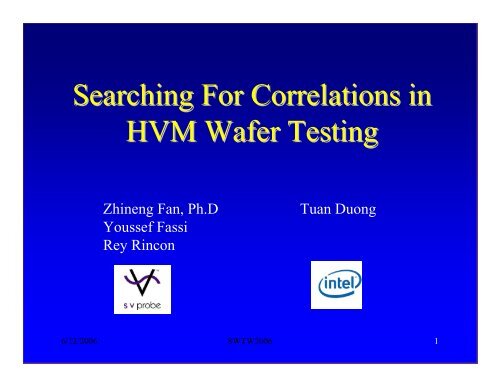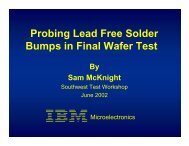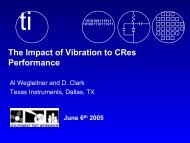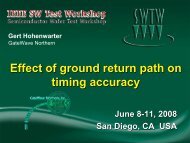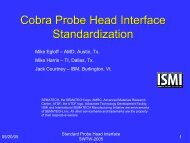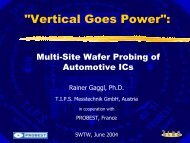Searching For Correlations in HVM Wafer Testing
Searching For Correlations in HVM Wafer Testing
Searching For Correlations in HVM Wafer Testing
You also want an ePaper? Increase the reach of your titles
YUMPU automatically turns print PDFs into web optimized ePapers that Google loves.
<strong>Search<strong>in</strong>g</strong> <strong>For</strong> <strong>Correlations</strong> <strong>in</strong><br />
<strong>HVM</strong> <strong>Wafer</strong> Test<strong>in</strong>g<br />
Zh<strong>in</strong>eng Fan, Ph.D<br />
Youssef Fassi<br />
Rey R<strong>in</strong>con<br />
Tuan Duong<br />
6/12/2006 SWTW2006 1
Agenda<br />
1. Introduction<br />
2. Direct Correlation Model<br />
3. Proposed Correlation Model<br />
– Model<strong>in</strong>g<br />
– Validation<br />
4. Application Example<br />
5. Limitations/Next step<br />
6. Summary<br />
2
Introduction<br />
Current Status<br />
• Cost benefit relationship between suppliers and down stream<br />
customer is not clear<br />
• Probe card manufacturers speaks a different language than their<br />
customers<br />
• Probe card suppliers critical parameters do not directly correlate to<br />
test floor performance<br />
Probe Card Supplier Critical<br />
Parameters<br />
• <strong>For</strong>ce<br />
• Planarity<br />
• PCA Cres<br />
• Scrub<br />
• Alignment<br />
Test Floor Performance<br />
Indicators<br />
• B<strong>in</strong>n<strong>in</strong>g<br />
• <strong>Wafer</strong>s Per Setup<br />
• Resort Rate<br />
• <strong>Wafer</strong> Cres<br />
3
Direct Correlation Model<br />
Correlation map of<br />
contact force vs.<br />
wafer Cres. Data<br />
collected from<br />
multiple samples.<br />
No direct correlation<br />
identified<br />
Low High<br />
<strong>Wafer</strong> Cres<br />
Low<br />
Contact <strong>For</strong>ce<br />
High<br />
4
Direct Correlation Model<br />
Correlation map of<br />
wafer Cres vs.<br />
metrology Cres. Data<br />
collected from<br />
multiple samples.<br />
No direct correlation<br />
identified.<br />
Low High<br />
<strong>Wafer</strong> Cres<br />
Low<br />
PCA Cres<br />
High<br />
5
Why No Direct Correlation?<br />
Contact Model<br />
• Contact resistance is governed<br />
by A-spots which are random<br />
• Total area of A-spots depends<br />
on force, material properties,<br />
contact motion and surface<br />
condition<br />
• Test<strong>in</strong>g environment also<br />
affects Cres<br />
A-spots<br />
6
Why No Direct Correlation?<br />
• The contact performance is determ<strong>in</strong>ed by the<br />
<strong>in</strong>terface quality. Probe card manufacturers control<br />
half of this. The other half is controlled by the<br />
down stream customers<br />
• There are real contact <strong>in</strong>terface differences<br />
between the metrology tools used for quality<br />
check and the test floor environment<br />
– Different material properties<br />
– Different surface cleanl<strong>in</strong>ess<br />
– Different topography<br />
– Different contact motion<br />
7
Proposed Correlation Model<br />
• In a run-to-fail model, wafers per setup (WPS) is a<br />
performance <strong>in</strong>dicator that counts wafers from fail-to-fail<br />
• If a simple probability model can describe WPS, we are<br />
able to correlate the model parameters to p<strong>in</strong> level fail<br />
probability that can be extracted from Cres - contact force<br />
data when setup is only broken by high Cres<br />
Cres – Contact<br />
<strong>For</strong>ce data<br />
P<strong>in</strong> level fail<br />
probability<br />
Setup break<br />
event (Cres<br />
as only<br />
criteria <strong>in</strong><br />
current<br />
model)<br />
<strong>Wafer</strong>s per<br />
setup<br />
8
<strong>Wafer</strong>s Per Setup Distribution<br />
<strong>Wafer</strong>s per setup<br />
<strong>Wafer</strong>s per setup<br />
In the above population, WPS follows an exponential distribution<br />
9
<strong>Wafer</strong>s Per Setup Distribution<br />
• Exponential distribution:<br />
P(<br />
t)<br />
= λe<br />
−λ t<br />
where, λ is the only characteristic parameter determ<strong>in</strong><strong>in</strong>g<br />
the distribution<br />
• The wafer sort<strong>in</strong>g process can be simulated as a Poisson<br />
process which can be easily programmed<br />
Poisson process<br />
Event<br />
Wait<strong>in</strong>g time<br />
<strong>Wafer</strong> Test<strong>in</strong>g<br />
Setup fail<br />
<strong>Wafer</strong>s per setup<br />
10
Validation<br />
• To validate the simulation, a probe card is populated with a 300 IO<br />
probe array<br />
• The wafers per setup data were simulated and the p<strong>in</strong> level probability<br />
of setup fails was extracted.<br />
8<br />
6<br />
<strong>Wafer</strong>s Per Setup Distribution<br />
of 300 Probe Array<br />
100%<br />
80%<br />
60%<br />
Count<br />
4<br />
40%<br />
20%<br />
Accumulated Percentage<br />
of 300 Probe Array<br />
2<br />
0%<br />
0<br />
<strong>Wafer</strong>s Per Setup<br />
Actual Data<br />
Simulated Data<br />
11
Validation<br />
• The same probe card is then populated with a 600 IO probe array<br />
• Apply<strong>in</strong>g the p<strong>in</strong> level probability extracted from the previous<br />
experiment to the model, we simulate the new wafers per setup<br />
distribution<br />
Count<br />
1200<br />
800<br />
400<br />
<strong>Wafer</strong>s Per Setup Distribution<br />
of 600 Probe Array<br />
100% 1<br />
80% 0.8<br />
60%<br />
0.6<br />
40% 0.4<br />
20%<br />
0.2<br />
Accumulated Percentage<br />
of 600 Probe Array<br />
0<br />
<strong>Wafer</strong>s Per Setup<br />
0<br />
Simulated Data<br />
12
Validation<br />
• The probe cards are then released to the field.<br />
• Actual wafers per setup data match very well with the simulation<br />
results<br />
14<br />
12<br />
10<br />
8<br />
<strong>Wafer</strong>s Per Setup Distribution<br />
of 600 Probe Array<br />
100%<br />
80%<br />
60%<br />
Count<br />
6<br />
4<br />
40%<br />
20%<br />
Accumulated Percentage<br />
of 600 Probe Array<br />
2<br />
0%<br />
0<br />
<strong>Wafer</strong>s Per Setup<br />
Actual Data<br />
Simulated Data<br />
13
Proposed Correlation Model<br />
When the floor test data is not available for extract<strong>in</strong>g p<strong>in</strong><br />
level probability, Cres- contact force data can be collected<br />
for estimat<strong>in</strong>g the p<strong>in</strong> level probability.<br />
Proposed<br />
Cres – Contact<br />
<strong>For</strong>ce data<br />
P<strong>in</strong> level fail<br />
probability<br />
Setup break<br />
event (Cres<br />
as only<br />
criteria <strong>in</strong><br />
current<br />
model)<br />
<strong>Wafer</strong>s per<br />
setup<br />
Validation<br />
14
P<strong>in</strong> Level Probability<br />
Calculation Method<br />
• Test probe cards us<strong>in</strong>g a<br />
medium as close to field<br />
conditions as possible<br />
• Collect a statistically<br />
significant amount of<br />
data<br />
• Extract p<strong>in</strong> level Cres<br />
fail probability<br />
Contact Resistance<br />
Contact <strong>For</strong>ce<br />
15
Simulation<br />
Assumptions:<br />
• 300 IO<br />
• 400 die/wafer<br />
• Cres fail at >10 Ohm<br />
• Setup fails at >5 occurrence high Cres fail<br />
Simulation Results:<br />
• Average wafers per setup: 35<br />
0 100 200 300 400 500<br />
3000<br />
2000<br />
1000<br />
Count Axis<br />
Exponential Plot<br />
10<br />
9<br />
8<br />
7<br />
6<br />
5<br />
.01<br />
4<br />
3<br />
.05<br />
.1<br />
2<br />
.2<br />
.3<br />
1<br />
.4<br />
.5<br />
0<br />
.9<br />
0 50 100 150 200 250 300 350<br />
<strong>Wafer</strong>s Per Setup<br />
-log(Surv)<br />
16
Limitation of the Current<br />
Model<br />
• The model assumes each high Cres fail event is <strong>in</strong>dependent. In<br />
the reality, one fail may impact the probability for next fail<br />
• The model treats every p<strong>in</strong> statistically equal. In reality, they are<br />
different, depend<strong>in</strong>g on components, geographical location, etc<br />
• The model assumes a constant probability across a probe card<br />
lifetime. In reality, the probability <strong>in</strong>creases as a function of life<br />
• The model does not <strong>in</strong>clude <strong>in</strong>tentional <strong>in</strong>terference dur<strong>in</strong>g the<br />
process, such as <strong>in</strong> process assistance<br />
• This research is based on s<strong>in</strong>gle product l<strong>in</strong>e. We do not have<br />
enough data to tell how widely exponential distribution can be<br />
applied to other products.<br />
17
Next Step<br />
• Extend the model to accommodate variable<br />
probability<br />
• Study what sample size is needed for WPS<br />
estimation<br />
• Add cost model to the simulation to<br />
evaluate the cost benefit relationship<br />
18
Interface<br />
Probe card<br />
Prob<strong>in</strong>g<br />
procedure and<br />
<strong>Wafer</strong><br />
Collected<br />
Cres – contact<br />
force data<br />
Summary<br />
Extracted<br />
P<strong>in</strong> level fail<br />
probability<br />
Calculated<br />
Setup break<br />
event (Cres<br />
as only<br />
criteria <strong>in</strong><br />
current<br />
model)<br />
<strong>Wafer</strong>s<br />
per<br />
setup<br />
• Demonstrated a simulation method to correlate the p<strong>in</strong> level probability to wafers<br />
per setup<br />
• The p<strong>in</strong> level probability can be extracted from Cres – contact force data<br />
• There are limitations on the current model. We will add more functionality at next<br />
step<br />
19


